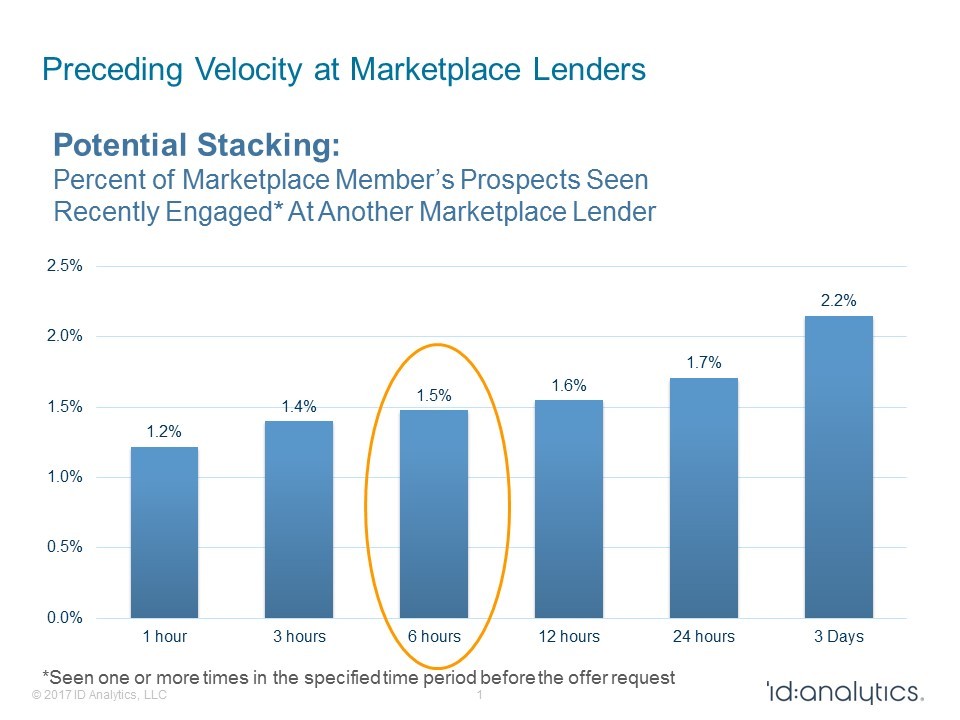Marketplace Lending
Are Those Shopping for an Online Loan More Risky?
March 18, 2017ID Analytics is enabling online lenders to know a thing or two they might not be able to find out on their own. For example, did a loan applicant apply for other loans on the same day? There’s a good chance ID Analytics can tell you the answer since they claim their Online Lending Network has achieved visibility into 75% of marketingplace lending activity in the US.
Their network includes business lenders but it’s the individuals behind the businesses that they monitor and data shows that 1.5% of online loan applicants applied for additional loans elsewhere within six hours of submitting their application. Conventional wisdom might suggest that a shopping borrower is an engaged and responsible borrower but ID Analytics’ early research found that this group was twice as risky as the average online loan applicant.
During a brief interview at LendIt, company VP Patrick Reemts said that their service isn’t limited to the point-of-application. Members can monitor their borrowers for up to 90 days and see if they apply for other loans or take other loans, Reemts explained. How lenders make use of that data is up to them though, he added.
Members of the Online Lending Network must report all their volume for the value of the data to be effective. They can’t selectively decide which applicants or borrowers to put in the system. ID Analytics is also not a startup, Reemts said. Having been in business for 15 years, they’re tapped into some of the nation’s largest credit card issuers so they have visibility into traditional credit sources too.
The company is a subsidiary of LifeLock, Inc.

How Whitepages Turned Their Data into an Identity Verification Tool for Online Lenders
March 15, 2017 Whitepages might be a 20-year old company but the data they’ve amassed over time can add significant value to online lenders, the company claims. Whitepages Pro, which offers identify verification, allows lenders to gauge if an individual is real. “It examines fraud risk, not credit risk,” company CEO Rob Eleveld said in a brief interview at LendIt last week.
Whitepages might be a 20-year old company but the data they’ve amassed over time can add significant value to online lenders, the company claims. Whitepages Pro, which offers identify verification, allows lenders to gauge if an individual is real. “It examines fraud risk, not credit risk,” company CEO Rob Eleveld said in a brief interview at LendIt last week.
A simple query of an individual’s name, phone number, email, address or business name will return results not easily accessible elsewhere, like how long that person’s email address has been in their system or the likelihood that the email address was generated by a bot, not a real person. A match is good, no match might not be good, they say. Their system can also do things like identify the carrier the phone number belongs to and whether or not that carrier, if it’s VOIP or something, might have a higher propensity for fraud.
Eleveld said that an impostor could try applying for a loan with a stolen social security number, but it’s harder for them to fake an entire online profile. These queries, he confirmed, can all be done through an API since online lenders are typically driven by speed. Big names are already using it such as Quicken Loans and loandepot, and those are just a couple of names from the online lending space alone.
“The company houses more than 5 billion global identity records,” according to their website, and customers such as “Wells Fargo, Microsoft, Western Union, Under Armour, Priceline, and American Airlines use Whitepages Pro data to mitigate risk and improve the customer experience.”
See You At LendIt
March 3, 2017Monday kicks off the LendIt conference at the Javits Center in NYC. Given that it’s the biggest event of the year for the industry, I certainly hope to meet as much of you there as possible.
If you still haven’t registered, make sure you at least take advantage of a 15% discount by using promo code: Debanked17USA. My schedule is pretty booked up, fueled in part by the excellent session topics this year which I want to catch a bunch of. That being the case, I am potentially available to get together even on Sunday or Wednesday (since I live in Manhattan) or any other day outside of the conference.
I hope you enjoy LendIt. You should check out their story of how they came to be HERE.
In The UK, Regulators Advise Where The Line Between Banks and Non-banks Lies
March 1, 2017Online lenders shouldn’t be borrowing money from other online lenders and using that money to lend, the Financial Conduct Authority in the UK warned on Tuesday. Doing so without regulatory permission, they explained, would constitute accepting deposits and be a criminal offense.
A copy of the official letter signed by Jonathan Davidson, Director of Supervision – Retail and Authorisations, is publicly available.
According to the Financial Times, the warning was prompted after RateSetter asked the government in October 2016 if such activity was acceptable. They had been engaged in such wholesale lending, as it’s called, since 2016 but have since stopped.
Prosper, A Marketplace for the World’s Richest Banks and Billionaires?
February 28, 2017
Credit Suisse, Deutsche Bank, Goldman Sachs, Morgan Stanley, and funds tied to some of the world’s richest billionaires (including George Soros) all make up the “consortium of institutional investors” and “syndicate of lenders” involved in Prosper’s recently announced landmark deal. The terms allow for the investors to purchase up to $5 billion of loans on the platform while the lenders will provide warehouse financing up to $1 billion. It’s safe to say that this is not your father’s peer-to-peer lender.
The WSJ reported too that investors will receive warrants to buy equity in Prosper that’s tied to the amount of loans they buy, all the way up to 35% of the company if they buy the full $5 billion.
Prosper used to call itself a “peer-to-peer lending marketplace” but these days it’s adopted a slightly different label, “consumer lending marketplace.”
Back in July, I half-jokingly scoffed at the phrase marketplace lending as the industry had begun to call itself, seeing that it was morphing into just Wall Street lending after Goldman Sachs announced it would actually be launching an online consumer lending arm to compete against Lending Club and Prosper.
The deal is obviously great for Prosper, whose future seemed kind of up in the air, but it’s hard to get excited about the world’s biggest banks and richest funds now being the consortium behind an online lender who pioneered peer-to-peer lending, if things like peer-to-peer lending excited you.
To be fair, peers/retail investors can still invest on the platform too so I guess there’s that.
For Lending Club Borrowers, Interest Now Accrues During Grace Periods
February 26, 2017On February 24th, Lending Club eliminated a courtesy that had long been afforded to borrowers, interest waivers during grace periods. Specifically, borrowers who missed a monthly payment were given 15 extra days to make the payment with no extra interest assessed or late fees. Going forward, interest will indeed accrue during grace periods.
“we are eliminating the grace period interest waiver in order to better align borrower payment incentives as we seek to deliver solid returns to our investors,” Lending Club said in an email.
Since this will not affect a borrower’s monthly payment, all additional accrued interest will be extended to another month beyond the maturity date.
Catching Up With Marketplace Lending – A Timeline
February 20, 2017This is the expanded update to the timeline of events taking place in the industry.
12/16 Chicago-based Argon Credit filed for bankruptcy
12/20 Bizfi announced that it had surpassed $2 billion in originations since inception
1/4 Strategic Funding integrated US operations of Capify
1/9 Two US Senators protested the OCC’s plans to create a limited fintech charter
1/11 Funding Circle announced a new $100 million equity round led by Accel
1/12 Marketplace Lending Association announced 11 new members
1/16
- The WSJ broke a story revealing that CAN Capital had breached its covenants with its big-bank creditors, laid off about 250 staffers, hired a restructuring firm for assistance in negotiating with creditors, and hired Jefferies Group for advice on strategic alternatives
- NY proposed broad changes to its lender licensing laws
1/17
- OnDeck announced a partnership with Wex, a provider of corporate and small business payment solutions
- New York Department of Financial Services protested the OCC’s plans to create a limited fintech charter
1/18 Credible raised $10 million in a Series B round from investors that included Ron Suber, the president of Prosper Marketplace.
1/19
- LendIt announced finalists of its first ever industry awards
- Sean Murray of deBanked selected as a finalist for Best Journalist Coverage
1/20
- Fifth Third announced a partnership with QED Investors to advance fintech strategy
- President Trump issued an executive order freezing all new regulations
1/25 loanDepot surpassed $100 billion in loans
1/26 LendingRobot launched a marketplace lending hedge fund
1/30 Prosper Marketplace’s EVP of capital markets, Eric Thaller, departed from the company
2/1 Prosper Marketplace appointed new CFO, Usama Ashraf
2/4 OnDeck announced departure of COO James Hobson
2/8
- Breakout Capital announced a $25 million credit facility
- Lendio announced that it had facilitated $240 million in funding last year
2/13 OnDeck announced a partnership with payroll company Wave
2/14 Lending Club reported a $146 million loss for the year and an increase in bank funding
2/16
- OnDeck reported a $86 million loss for the year, layoffs
- The DC circuit decided to rehear the PHH v CFPB case
‘Peers’ Continue Retreat from Lending Club
February 18, 2017 The peer aspect of peer-to-peer lending continued to erode last year, according to Lending Club’s year-end earnings presentation. Self-managed individuals, those still making their own investment decisions, only made up $263 million of their 4th quarter’s origination volume, reaching the lowest level in two years. That’s nearly 38% lower from the peak of $419 million in Q1 of 2016.
The peer aspect of peer-to-peer lending continued to erode last year, according to Lending Club’s year-end earnings presentation. Self-managed individuals, those still making their own investment decisions, only made up $263 million of their 4th quarter’s origination volume, reaching the lowest level in two years. That’s nearly 38% lower from the peak of $419 million in Q1 of 2016.
Overall monthly originations haven’t really moved, hovering at around $2 billion per quarter over the last 3 quarters, down from the peak of 2016’s Q1 when they hit $2.75 billion. There’s money coming from somewhere though, of course. A chart in the presentation revealed that 74% of Lending Club’s Q4 originations came from banks and managed accounts. The managed accounts category is comprised primarily of asset managers who invest mainly in marketplace lending.
A glance at Lending Club’s self-managed individual originations as a percentage of total originations per quarter is below:
| Q4 2013 | Q1 2014 | Q2 2014 | Q3 2014 | Q4 2014 | Q1 2015 | Q2 2015 | Q3 2015 | Q4 2015 | Q1 2016 | Q2 2016 | Q3 2016 | Q4 2016 |
| 27% | 27% | 23% | 25% | 19% | 19% | 15% | 15% | 13% | 15% | 17% | 14% | 13% |
Retail investors were largely skimmed over during the Q4 earnings call, with CEO Scott Sanborn and CFO Tom Casey choosing to focus their attention on bank participation. “As you know, banks returning to the platform has been a priority for us and acts as an endorsement of our strength and compliance and controls,” Casey said.
Using the Seeking Alpha transcript as a guide, the word bank was said on the call 32 times while retail investor was only mentioned once.
To that end, Lending Club’s announcement highlighted its bank funding achievement.
Meanwhile, the word retail doesn’t exist anywhere in the announcement unless you count the necessary Safe Harbor Statement.
RIP the retail investor.






























